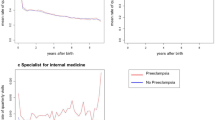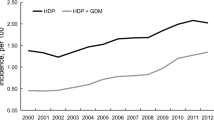Abstract
The objective of this study was to examine the association between maternal insurance status and maternal and neonatal adverse outcomes in women who had hypertensive disorders in pregnancy. A population-based retrospective cohort study was undertaken using the US Vital Statistics dataset on Period Linked Birth-Infant Data from 2016–2020. The study population was restricted to non-anomalous births from women whose pregnancies were complicated by hypertensive disorders. Insurance status was categorized as private, Medicaid, self-pay and other. The primary outcome was a composite of maternal adverse outcomes, which included admission to the intensive care unit, unplanned hysterectomy, maternal blood transfusion or uterine rupture. We examined the role of prenatal care in these relationships using a mediation analysis with Kotelchuck’s Adequacy of Prenatal Care Utilization Index. Multivariable logistic regression models were used to estimate the association between maternal insurance status and adverse outcomes (using adjusted odds ratios [aOR] and 99% confidence interval [CI]). Of the 18,999,865 live births in the five-year study, 1,642,654 (8.6%) met the inclusion criteria. The frequency of the composite maternal adverse outcome was 1.3%. The maternal composite occurred more frequently in women with Medicaid (aOR = 1.11, 99% CI: 1.06, 1.16) or self-pay (aOR = 1.40, 99% CI: 1.25, 1.55) when compared to private insurance. Adjusting for prenatal care slightly attenuated this association, but remained significant. Among women with hypertensive disorders in pregnancy, women with Medicaid insurance or self-pay were more likely to experience maternal and neonatal adverse outcomes than women with private insurance.
This is a preview of subscription content, access via your institution
Access options
Subscribe to this journal
Receive 12 digital issues and online access to articles
$119.00 per year
only $9.92 per issue
Buy this article
- Purchase on Springer Link
- Instant access to full article PDF
Prices may be subject to local taxes which are calculated during checkout

Similar content being viewed by others

Data availability
The data for this project is publicly available.
References
Butwick AJ, Druzin ML, Shaw GM, Guo N. Evaluation of US state-level variation in hypertensive disorders of pregnancy. JAMA Netw Open. 2020;3:e2018741.
Kuklina EV. Hypertension in pregnancy in the US-one step closer to better ascertainment and management. JAMA Netw Open. 2020;3:e2019364.
Cameron NA, Everitt I, Seegmiller LE, Yee LM, Grobman WA, Khan SS. Trends in the incidence of new-onset hypertensive disorders of pregnancy among rural and urban areas in the United States, 2007 to 2019. J Am Heart Assoc. 2022;11:e023791.
Gestational Hypertension and Preeclampsia: ACOG practice bulletin summary, Number 222. Obstet Gynecol. 2020;135:1492–5.
Abdelazim IA, Bekmukhambetov Y, Aringazina R, Shikanova S, Amer OO, Zhurabekova G, et al. The outcome of hypertensive disorders with pregnancy. J Fam Med Prim Care. 2020;9:1678–83.
Pauli JM, Repke JT. Preeclampsia: short-term and long-term implications. Obstet Gynecol Clin North Am. 2015;42:299–313.
Wagner SM, Chen H-Y, Gupta M, Bicocca MJ, Mendez-Figueroa H, Chauhan SP. Association between time of delivery and composite adverse outcomes in pregnancies complicated by hypertensive disorders. Hypertens Pregnancy. 2021;40:246–53.
Bartsch E, Medcalf KE, Park AL, Ray JG. High risk of pre-eclampsia identification G. Clinical risk factors for pre-eclampsia determined in early pregnancy: systematic review and meta-analysis of large cohort studies. BMJ. 2016;353:i1753.
Sibai BM, Hauth J, Caritis S, Lindheimer MD, MacPherson C, Klebanoff M, et al. Hypertensive disorders in twin versus singleton gestations. National Institute of Child Health and Human Development Network of Maternal-Fetal Medicine Units. Am J Obstet Gynecol. 2000;182:938–42.
Zhang S, Cardarelli K, Shim R, Ye J, Booker KL, Rust G. Racial disparities in economic and clinical outcomes of pregnancy among Medicaid recipients. Matern Child Health J. 2013;17:1518–25.
Cha AE, Cohen RA. Demographic variation in health insurance coverage: United States, 2020. Natl Health Stat Report. 2022;159:1–15.
Greiner KS, Speranza RJ, Rincón M, Beeraka SS, Burwick RM. Association between insurance type and pregnancy outcomes in women diagnosed with hypertensive disorders of pregnancy. J Matern Fetal Neonatal Med. 2020;33:1427–33.
Kotelchuck M. The Adequacy of Prenatal Care Utilization Index: its US distribution and association with low birthweight. Am J Public Health. 1994;84:1486–9.
von Elm E, Altman DG, Egger M, Pocock SJ, Gotzsche PC, Vandenbroucke JP, et al. The Strengthening the Reporting of Observational Studies in Epidemiology (STROBE) Statement: guidelines for reporting observational studies. Int J Surg. 2014;12:1495–9.
Langenveld J, Ravelli AC, van Kaam AH, van der Ham DP, van Pampus MG, Porath M, et al. Neonatal outcome of pregnancies complicated by hypertensive disorders between 34 and 37 weeks of gestation: a 7 year retrospective analysis of a national registry. Am J Obstet Gynecol. 2011;205:540.e1–7.
Tsujimoto Y, Kataoka Y, Banno M, Taito S, Kokubo M, Masuzawa Y, et al. Association of low birthweight and premature birth with hypertensive disorders in pregnancy: a systematic review and meta-analysis. J Hypertens. 2022;40:205–12.
Daw JR, Hatfield LA, Swartz K, Sommers BD. Women in the United States experience high rates of coverage ‘churn’ in months before and after childbirth. Health Aff. 2017;36:598–606.
Bensken WP, Ciesielski TH, Williams SM, Stange KC, Sajatovic M, Koroukian SM. Inconsistent medicaid coverage is associated with negative health events for people with epilepsy. J Health Care Poor Underserved. 2022;33:1036–53.
Erskine NA, Waring ME, McManus DD, Lessard D, Kiefe CI, Goldberg RJ. Barriers to healthcare access and long-term survival after an acute coronary syndrome. J Gen Intern Med. 2018;33:1543–50.
Oso AA, Adefurin A, Benneman MM, Oso OO, Taiwo MA, Adebiyi OO, et al. Health insurance status affects hypertension control in a hospital based internal medicine clinic. Int J Cardiol Hypertens. 2019;1:100003.
Bombard JM, Robbins CL, Dietz PM, Valderrama AL. Preconception care: the perfect opportunity for health care providers to advise lifestyle changes for hypertensive women. Am J Health Promot. 2013;27:S43–9.
Murray Horwitz ME, Rodriguez MI, Dissanayake M, Carmichael SL, Snowden JM. Postpartum health risks among women with hypertensive disorders of pregnancy, California 2008-2012. J Hypertens. 2021;39:1009–17.
ACOG Committee Opinion No. 748: the importance of vital records and statistics for the obstetrician-gynecologist. Obstet Gynecol. 2018;132:e78–e81.
Schoendorf KC, Branum AM. The use of United States vital statistics in perinatal and obstetric research. Am J Obstet Gynecol. 2006;194:911–5.
Grimes DA, Schulz KF. False alarms and pseudo-epidemics: the limitations of observational epidemiology. Obstet Gynecol. 2012;120:920–7.
Author information
Authors and Affiliations
Contributions
FA: Conceptualization, Methodology, Formal Analysis, Data Curation. RB: Visualization, Supervision, Writing – Review and Editing. MG: Conceptualization, Writing- Review and Editing. MFB: Conceptualization, Writing- Review and Editing. MJB: Conceptualization. SPC: Supervision. SW: Conceptualization, Project administration, Writing- Original Draft.
Corresponding author
Ethics declarations
Competing interests
The authors declare no competing interests.
Additional information
Publisher’s note Springer Nature remains neutral with regard to jurisdictional claims in published maps and institutional affiliations.
Supplementary information
Rights and permissions
Springer Nature or its licensor (e.g. a society or other partner) holds exclusive rights to this article under a publishing agreement with the author(s) or other rightsholder(s); author self-archiving of the accepted manuscript version of this article is solely governed by the terms of such publishing agreement and applicable law.
About this article
Cite this article
Allouch, F., Burwick, R., Gupta, M. et al. The association between maternal insurance status on maternal and neonatal outcomes in women with hypertensive disorders of pregnancy. J Hum Hypertens 38, 75–80 (2024). https://doi.org/10.1038/s41371-023-00809-x
Received:
Revised:
Accepted:
Published:
Issue Date:
DOI: https://doi.org/10.1038/s41371-023-00809-x


